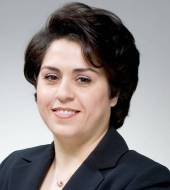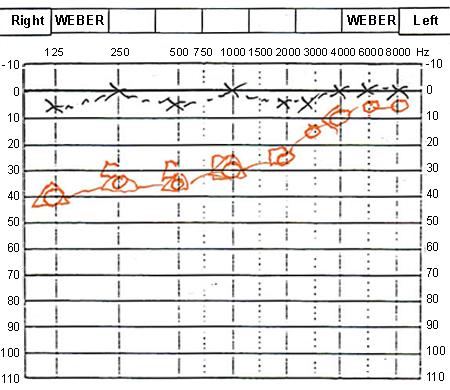Resumen
Definición
Anamnesis y examen
Principales factores de diagnóstico
- vertigo
- hearing loss
- tinnitus
- aural fullness
- drop attacks
Otros factores de diagnóstico
- positive Romberg test
- Fukuda stepping test
- bilateral symptoms
- nystagmus
- tandem walk
Factores de riesgo
- recent viral infection
- genetic predisposition
- autoimmune disease
- increasing age
Pruebas diagnósticas
Primeras pruebas diagnósticas para solicitar
- pure-tone air and bone conduction with masking
- speech audiometry
- tympanometry/immittance/stapedial reflex levels
- otoacoustic emissions (OAE)
Pruebas diagnósticas que deben considerarse
- electrocochleography
- electronystagmography
- rotary chair test
- vestibular-evoked myogenic potential (VEMP)
- MRI of internal auditory canals
- thyroid function tests
- Lyme disease and syphilis serology
- antinuclear antibody
- antineutrophil cytoplasmic antibody
- rheumatoid factor
Pruebas emergentes
- 3-dimensional MRI
Algoritmo de tratamiento
all patients
persistent hearing loss
failure of medical and intratympanic therapies; hearing adequate
failure of medical and intratympanic therapies; hearing severely impaired
Colaboradores
Autores
Soha N. Ghossaini, MD, FACS

Otology-Neurotology
Ear Nose and Throat Associates of New York
New York
NY
Divulgaciones
SNG declares that she has no competing interests.
Agradecimientos
Dr Ghossaini would like to gratefully acknowledge the late Professor Maurice H. Miller, a previous contributor to this topic. MHM declared that he had no competing interests.
Revisores por pares
Steven D. Rauch, MD
Associate Professor of Otology and Laryngology
Harvard Medical School
Boston
MA
Divulgaciones
SDR declares that he has no competing interests.
Christopher J. Linstrom, MD
Professor
Otolaryngology/Head and Neck Surgery
The New York Eye and Ear Infirmary
Surgeon Director
New York
NY
Declarações
CJL declares that he has no competing interests.
Peter Rea, MA, BM BCh, FRCS(ORL-HNS)
Consultant ENT Surgeon
Leicester Royal Infirmary
Leicester
UK
Declarações
PR declares that he has no competing interests.
Doris Eva Bamiou, MD, MSc, PhD
Clinical Senior Lecturer & Consultant in Audiovestibular Medicine
Ear Institute
University College London
London
UK
Declarações
DEB declares that she has no competing interests.
Créditos aos pareceristas
Os tópicos do BMJ Best Practice são constantemente atualizados, seguindo os desenvolvimentos das evidências e das diretrizes. Os pareceristas aqui listados revisaram o conteúdo pelo menos uma vez durante a história do tópico.
Declarações
As afiliações e declarações dos pareceristas referem--se ao momento da revisão.
Referências
Principais artigos
Goebel JA. 2015 Equilibrium Committee amendment to the 1995 AAO-HNS guidelines for the definition of Ménière's disease. Otolaryngol Head Neck Surg. 2016 Mar;154(3):403-4. Resumo
Basura GJ, Adams ME, Monfared A, et al. Clinical practice guideline: Ménière's disease. Otolaryngol Head Neck Surg. 2020 Apr;162(suppl 2):S1-55.Texto completo Resumo
Lopez-Escamez JA, Carey J, Chung WH, et al; Classification Committee of the Barany Society; Japan Society for Equilibrium Research; European Academy of Otology and Neurotology (EAONO); Equilibrium Committee of the American Academy of Otolaryngology-Head and Neck Surgery (AAO-HNS); Korean Balance Society. Diagnostic criteria for Menière's disease. J Vestib Res. 2015;25(1):1-7.Texto completo Resumo
American College of Radiology. ACR appropriateness criteria: hearing loss and/or vertigo. 2018 [internet publication].Texto completo
Artigos de referência
Uma lista completa das fontes referenciadas neste tópico está disponível para os usuários com acesso total ao BMJ Best Practice.

Diagnósticos diferenciais
- Acoustic neuroma
- Vestibular migraine (also called migraine-associated dizziness and migraine-associated vertigo)
- Vestibular neuronitis
Mais Diagnósticos diferenciaisDiretrizes
- Clinical practice guideline: Ménière's disease
- Clinical practice guideline: sudden hearing loss (update)
Mais DiretrizesFolhetos informativos para os pacientes
Tinnitus
Meniere disease
Mais Folhetos informativos para os pacientesConectar-se ou assinar para acessar todo o BMJ Best Practice
O uso deste conteúdo está sujeito ao nosso aviso legal